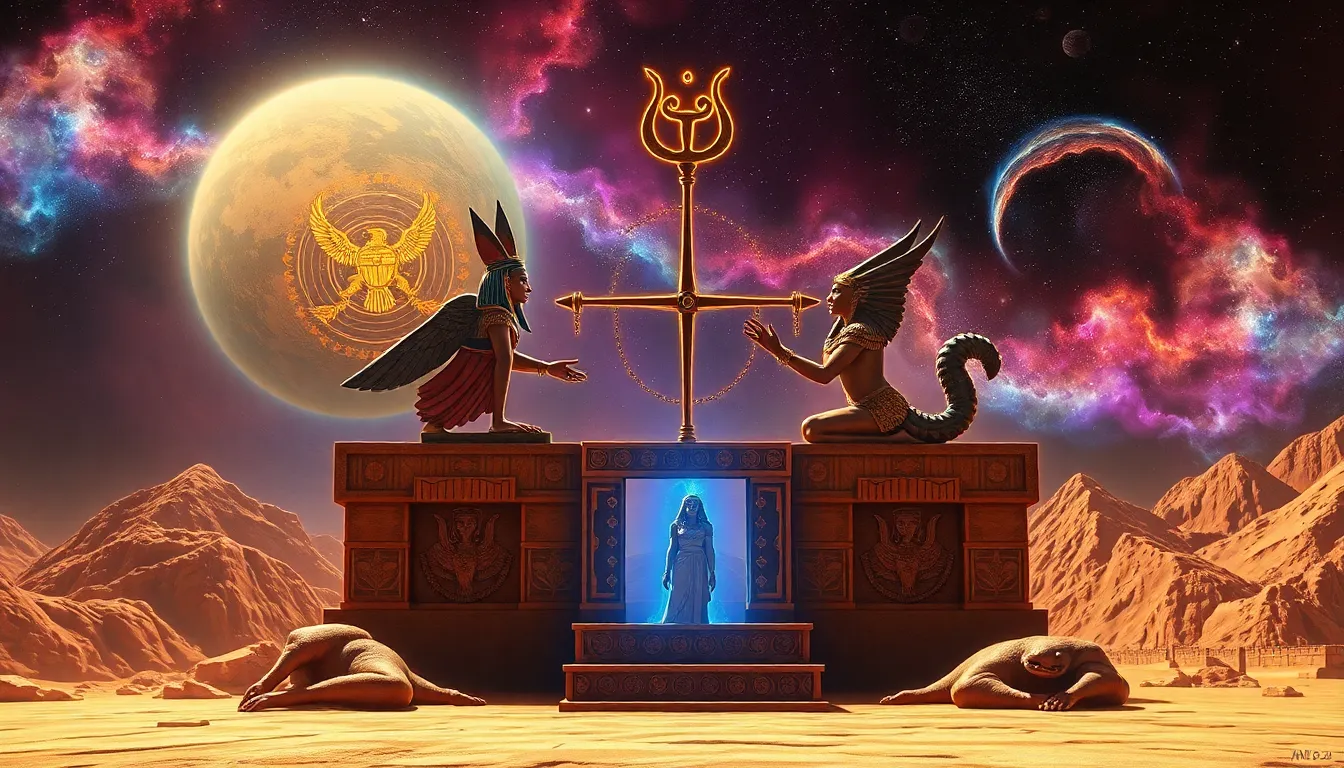The Divine Order: Ma’at and the Balance of the Universe
I. Introduction to Ma’at
In Ancient Egyptian culture, Ma’at represents a fundamental concept that encompasses truth, justice, and cosmic order. It is both a goddess and an abstract principle, embodying the essential balance that keeps the universe in harmony. The significance of Ma’at extends beyond mere mythology; it is a guiding force in the moral and ethical behaviors of the Ancient Egyptians, influencing their laws and daily lives.
II. Historical Context of Ma’at
A. Origins of Ma’at in Ancient Egyptian mythology
The origins of Ma’at can be traced back to the early dynastic period of Ancient Egypt, where she was revered as a key figure in the creation myth. According to Egyptian cosmology, Ma’at emerged at the beginning of time, establishing order from chaos. She was often depicted as a woman with an ostrich feather on her head, symbolizing truth and balance.
B. The role of Ma’at in the governance and daily life of Ancient Egyptians
Ma’at was not only a spiritual concept but also a practical one that influenced governance. Pharaohs were seen as the earthly embodiment of Ma’at, responsible for maintaining order and justice in their realms. The laws of the land were rooted in the principles of Ma’at, guiding rulers and citizens alike in their interactions.
III. The Symbolism of Ma’at
A. The iconography of Ma’at and her depictions in art
Ma’at is frequently depicted in Ancient Egyptian art, often represented as a woman with a feather on her head. She is sometimes shown holding an ankh (the symbol of life) and a sistrum (a musical instrument), signifying her connection to both life and harmony. Her imagery often appears in tombs and temples, reminding the deceased and the living of the importance of maintaining balance.
B. The significance of the feather of Ma’at in the judgment of souls
The feather of Ma’at plays a crucial role in the judgment of souls in the afterlife. In the Hall of Ma’at, the deceased’s heart is weighed against her feather. If the heart is lighter than the feather, the soul is deemed worthy, allowing entry into the afterlife. This act symbolizes the ultimate test of one’s life, embodying the concept of truth and justice.
IV. Ma’at and the Cosmic Order
A. Understanding the relationship between Ma’at and the universe
Ma’at is intrinsically tied to the cosmic order of the universe. The Ancient Egyptians believed that the natural world operates according to the principles of Ma’at, where every element exists in a delicate balance. This balance is crucial for sustaining life and ensuring the continuity of the cosmos.
B. How Ma’at embodies the principles of harmony and balance in nature
In nature, Ma’at manifests through cycles and rhythms—day and night, the Nile’s flooding and receding, and the seasons. These cycles reflect her influence, emphasizing the importance of maintaining equilibrium in all aspects of life. The Ancient Egyptians recognized that disruption of this balance could lead to chaos and disorder.
V. The Role of Ma’at in Egyptian Religion
A. Ma’at’s influence on the pantheon of gods and goddesses
Ma’at was a significant figure within the Egyptian pantheon, influencing other gods and goddesses. Deities such as Osiris, who presided over the afterlife, and Thoth, the god of wisdom and writing, were closely associated with her principles. Ma’at’s values were essential in the functioning of divine order, impacting mythological narratives and religious practices.
B. Rituals and practices associated with Ma’at in religious ceremonies
Rituals dedicated to Ma’at often involved offerings and prayers aimed at ensuring order and justice. Priests would recite hymns and perform ceremonies that reinforced the principles of Ma’at, seeking her blessings for the pharaoh and the people. Maintaining Ma’at was seen as essential for the prosperity and stability of the kingdom.
VI. The Impact of Ma’at on Justice and Ethics
A. Ma’at as a foundation for moral and ethical behavior
Ma’at served as the moral compass for the Ancient Egyptians, establishing a framework for ethical conduct. The tenets of Ma’at encouraged individuals to act with integrity, truthfulness, and fairness. This foundation for morality was essential not only for personal interactions but also for societal cohesion.
B. The concept of divine justice and its implications for humanity
The concept of divine justice, rooted in Ma’at, asserts that individuals are held accountable for their actions. This belief instilled a sense of responsibility among the people, as they understood that their deeds would be judged by Ma’at in the afterlife. Such accountability fostered a culture of respect and order.
VII. Contemporary Relevance of Ma’at
A. Modern interpretations and applications of Ma’at in society
In contemporary society, the principles of Ma’at continue to resonate. Concepts of justice, balance, and ethical behavior remain relevant in discussions of law, governance, and personal conduct. Many modern movements advocate for social justice, sustainability, and ethical leadership, echoing the teachings of Ma’at.
B. The significance of balance and justice in today’s world
Today, the need for balance and justice is more critical than ever. With challenges such as climate change, social inequality, and political unrest, the quest for harmony reflects the enduring legacy of Ma’at. Individuals and societies are called to embody these principles, striving for a world where truth and justice prevail.
VIII. Conclusion: The Enduring Legacy of Ma’at
A. Reflection on the importance of Ma’at in understanding the universe
Ma’at is a timeless concept, offering profound insights into the nature of existence and the human experience. Understanding Ma’at allows us to appreciate the interconnectedness of life and the importance of maintaining balance in all aspects of our lives.
B. The ongoing quest for balance and harmony in human life
The legacy of Ma’at challenges us to pursue balance and harmony actively. As we navigate the complexities of modern life, the principles of Ma’at remind us of our responsibility to ourselves, each other, and the world around us. The quest for justice, truth, and balance remains an essential part of the human journey.




